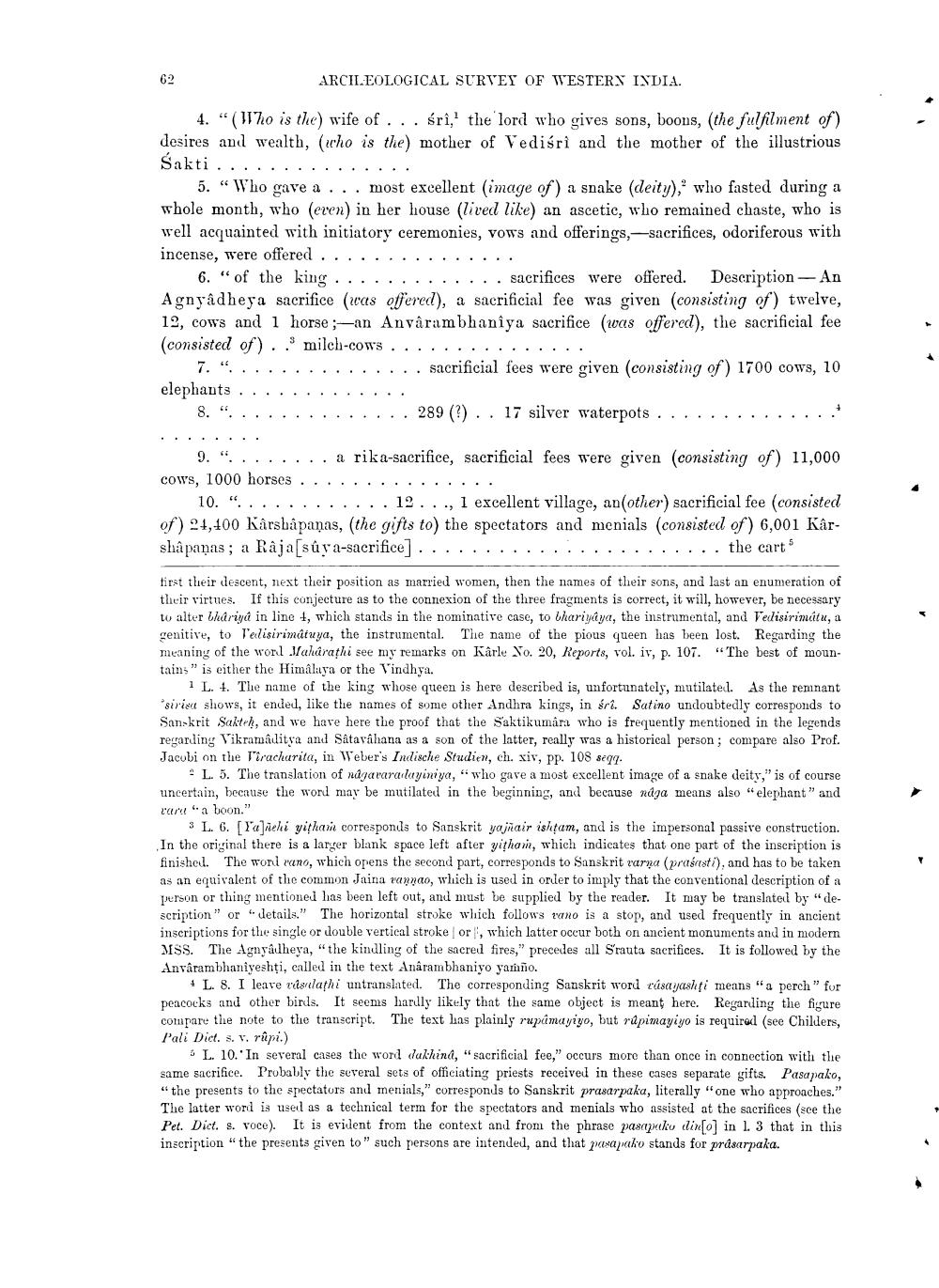________________
ARCILEOLOGICAL SURVEY OF WESTERN INDIA.
4. "(11ho is the wife of ... śrî,' the lord who gives sons, boons, (the fulfilment of) desires and wealth, (who is the) mother of Vediśrî and the mother of the illustrious Sakti ...............
5. "Who gave a ... most excellent (image of a snake (deity), who fasted during a whole month, who even) in her house (lived like) an ascetic, who remained chaste, who is well acquainted with initiatory ceremonies, vows and offerings,-sacrifices, odoriferous with incense, were offered ................
6. “ of the king . . . . . . . . . . . . . sacrifices were offered. Description - An Agnyâdheya sacrifice (was offered), a sacrificial fee was given (consisting of twelve, 12, cows and i horse ;-an Anvârambhanîya sacrifice (was offered), the sacrificial fee (consisted of)..milch-cows ...............
7. "... ... . . . . . . . . sacrificial fees were given (consisting of) 1700 cows, 10 elephants .............
8. ".............. 289 (?) . . 17 silver waterpots ..............
.... a rika-sacrifice, sacrificial fees were given (consisting of) 11,000 cows, 1000 horses ...............
10. "...........12 ..., 1 excellent village, an(other) sacrificial fee (consisted of) 24,400 Kårsbâpaņas, (the gifts to the spectators and menials (consisted of) 6,001 Kârshậpaņas; a Rajasůya-sacrifice]. ..................... the cart
first their descent, next their position as married women, then the names of their sona, and last an enumeration of their virtues. If this conjecture as to the connexion of the three fragments is correct, it will, however, be necessary tu alter bhariya in line , which stands in the nominative case, to bhariyaya, the instrumental, and Veilisirimatu, a genitive, to l'elisirimituya, the instrumental. The name of the pious queen has been lost. Regarding the meaning of the worl Jahürathi see my remarks on Kärle No. 20, Reports, vol. ir, p. 107. "The best of mountains" is either the Himalaya or the Vindhya.
1 L. 1. The name of the king whose queen is here described is, unfortunately, mutilatel. As the remnant 'sirisu shows, it ended, like the names of some other Andhra kings, in ấri. Satino undoubtedly corresponds to Sanskrit Sakteh, and we have here the proof that the Saktikumára who is frequently mentioned in the legends regarding Vikramaditya and Satavahana as a son of the latter, really was a historical person; compare also Prof. Jacobi on the l'irachurita, in Weber's Indische Studien, ch. xiv, pp. 108 seq.
- L. 5. The translation of någavararlayiniya, " who gave a most excellent image of a snake deity," is of course uncertain, because the word may be mutilated in the beginning, and because núga means also "elephant" and Lara boon."
L. 6. [Yaneli yithain corresponds to Sanskrit yajñair ishtam, and is the impersonal passive construction. In the original there is a larger blank space left after yitham, which indicates that one part of the inscription is finishel. The worl vano, which opens the second part, corresponds to Sanskrit rarna (praśnsti), and has to be taken as an equivalent of the common Jaina vannao, which is used in order to imply that the conventional description of a person or thing mentioned has been left out, and must be supplied by the reader. It may be translated by "description" or " details." The horizontal stroke which follows rano is a stop, and used frequently in ancient inscriptions for the single or double vertical stroke! or, which latter occur both on ancient monuments and in modem MSS. The Agnyâdheya, "the kindling of the sacred fires," precedes all Srauta sacrifices. It is followed by the Anvärambhaniyeshţi, called in the text Anârambhaniyo yanño.
+ L. 8. I leare risulathi untranslated. The corresponding Sanskrit word rúsayashti means "a perch" for peacocks and other birds. It seems hardly likely that the same object is meant here. Regarding the figure compare the note to the transcript. The text las plainly rupimayiyo, but rapimayiyo is required (see Childers, Pali Dict. s. v rûpi.)
L. 10. In several cases the word dakhind, "sacrificial fee," occurs more than once in connection with the same sacrifice. Probably the several sets of officiating priests received in these cases separate gifts. Pasapako, "the presents to the spectators and meninls, corresponds to Sanskrit prasarpaka, literally "one who approaches." The latter word is used as a technical term for the spectators and menials who assisted at the sacrifices (sce the Pet. Dict. s. voce). It is evident from the context and from the phrase pasapocku ilin[o] in 13 that in this inscription "the presents given to such persons are intended, and that parajako stands for präsarpaka.




